| Jules Verne, the father of science fiction, was the enormously popular best-selling author of a series of "fantastic voyages" that brought him immortal fame as well as earthly riches. Not all of his voyages fell into the science fiction genre (a term that didn't even exist at the time) and many were simply adventures, usually of an exotic nature and set in foreign lands. Around the World in 80 Days was one such adventure, a travelogue of sorts, really, doled out to his anxious and curious readers, like the work of Dickens, in newspaper installments rather than as we read them today in book form. In a day when much of the world was still mysterious and unknown, Verne's word pictures allowed readers to travel the planet and glimpse the marvels of the Earth. |
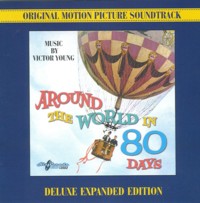 |
Similarly, in motion pictures of the 1950s, far-off lands were still usually created on the studio backlot. Although, movies, television and the print media had presented many views of foreign countries and customs, travel and its destinations was still considered unusual and exotic. So it was that filmmakers began traveling further afield, shooting their pictures "on location" in order to take advantage of seldom, if never, seen foreign sights. One of the films to take biggest advantage of this new trend was Michael Todd's gargantuan 1956 production of Around the World in 80 Days.
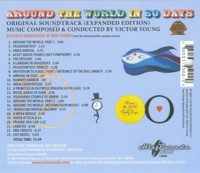 |
Mike Todd, the legendary showman, is best known today as the producer of Around the World in 80 Days, the force behind the development of the 70mm screen process Todd A-O, and the husband of Elizabeth Taylor, not necessarily in that order, but all three tied together (Todd acknowledges Taylor at film's end). Todd's film shot all over the world with one of the largest casts ever assembled for one picture. One might call it "stunt" casting when Todd talked over three dozen well known stars into performing what he dubbed "cameos," short, single scenes, sometimes barely a walk-through, for his movie. |
(For a complete listing of the incredible cast go to the IMDB entry on Around the World... )
Between the spectacular scenery, the spectacular stars and the spectacular huge screen Todd A-O process, audiences were wowed. Adjusted for inflation, the film went on to gross an astounding $357 million in the U.S. alone.
Oh, and the music. Don't forget the music. No small part of the movie's success must be given to the score by Victor Young. The title theme was one of the most popular and most recorded pieces of music of the decade. The soundtrack album, first released in monaural sound, then later in a stereo, was constantly in print for decades and spawned dozens of rival recordings. In short, there was probably a copy of this Decca album, or a rival recording, in almost every home that owned a record player. Certainly, the score, like the movie it was written for, is a crowd pleaser and one of the most enjoyable listening experiences of any soundtrack album released in the 1950s.
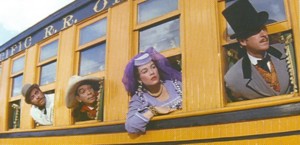 |
Now, acknowledging the motion picture's 50th anniversary, is a new, digitally remastered and greatly expanded recording of the original soundtrack cues. Unlike some expanded editions of soundtracks which increase the amount of music available but not necessarily the listening pleasure, this Hit Parade Records edition offers approximately 30 minutes of extra and extended cues from the original soundtrack recording that will have previous fans exultant. |
Didier C. Deutsch's reissue makes note that "the best possible analog sources" were used but there is no need for disclaimers here. The album maintains the recording's original cozy close-miked sound but is brighter, cleaner and clearer than the last CD edition issued on MCA.
Victor Young was a major studio composer, noted not only for his underscoring but also, and perhaps more so, for his ability to write hit tunes, a valuable asset to a film composer.
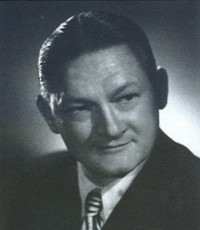 Victor Young
Victor Young |
By this time he had scored The Palm Beach Story (1942), For Whom the Bell Tolls (1943), The Paleface (1948), Samson and Delilah (1949), Sands of Iwo Jima (1949), The Quiet Man (1952), Shane (1953), Three Coins in the Fountain (1954), Johnny Guitar (1954), The Country Girl (1954) and Strategic Air Command (1955).
He scored several movies for Bob Hope (My Favorite Spy), John Wayne (Reap the Wild Wind) and Cecil B. DeMille (The Greatest Show on Earth) as well as many other top directors such as Frank Capra (State of the Union) and John Ford (Rio Grande), working in every genre from comedies to horror. Sadly, Young died near the time of the film's premiere and was awarded a posthumous Oscar during the 1957 ceremonies.
|
The album begins
The album begins with the best known piece of music from the film, "Around the World in 80 Days." Kicking off with a dramatic drum roll, a lush string section, horns, and a piano each take turns playing the lovely, elegant main theme. Originally, audiences had to wait until intermission to hear this piece since there was no opening title sequence. The actual titles for the movie were run at the end, a common occurrence today but highly unusual in 1954. This version is the original soundtrack version which gently tapers off and fades away in contrast to the earlier Lp release which was a version recorded specifically for record release. The score version ended with a dramatic crescendo and returned to the dramatic drums for a satisfying musical resolution.
The actual first four musical cues heard in the film are not on this recording. The film opens with Edward R. Murrow, the most respected newsman prior to Walter Cronkite, speaking on how the world has changed since the time of Jules Verne. As part of this introduction, the 1902 Georges Melies film Le Voyage dans la lune(A Trip to the Moon), derived from Verne, is shown in its entirety accompanied by a rinky-tink piano score.
After we have been shown space travel as imagined in the late 19th century the film shifts to color and widens to its full Todd A-O limits to present a modern rocket take-off and to display film footage of the Earth taken by a rocket in space. This gets its own dramatic and somewhat disturbing musical treatment. The film proper begins, and to indicate the setting, we are treated to a marching band rendition of "Rule Britannia" by the British Guards as the formation parades before the camera.
The fourth piece, second on this album, is the delightful, jaunty "Passepartout" theme written to represent the character, played by Mexico's leading comic actor, Cantinflas, a peformer often compared to Chaplin for his whimsical, innocent precociousness. However, the piece in the movie is quite different from this cue which presents the "Passepartout" theme in a cleaner, streamlined stand alone version. The original album combined this short piece with a later cue titled "Passepartout Dances" and used a musical bridge taken from later in the film (as they are about to arrive in Bombay) during which Inspector Fix (Robert Newton) attempts to pump the servant for information about his master.
Hit Parade restores the two cues to their proper sequence in the musical scheme but the bridge is now gone. The Passepartout theme is heard again while the servant acquaints himself with the finery of his new lodgings in the domicile of Phileas Fogg (David Niven). But this cue isn't on the album either. So, when all is said and done, this particular track on the album doesn't appear anywhere in the movie in that form. One can only surmise that Young wrote a special album version that didn't include any extraneous music that might detract from the main theme.
It's also a little strange that the track listed as "Entrance of the Bull March" simply isn't in the movie at all! It's of a piece with the rest of the music but comparing it with the film will verify that it somehow crept onto the album from the very beginning without actually making the final cut of the film. Perhaps it was written for the film and then, for some reason, not used. Regardless, it is better than the music actually used.
| "Paris Arrival" is a sprightly theme using the French dance music "Maxixe" which has become something of a cliche in indicating France or the Can-Can. Under Young's baton, though, it works as it plays over bustling crowds and Parisians looking out over their fair city.
A completely new addition to the album, "Sioux Attack" (8:14), is also a bit cliched -- representing a Native American sequence in the most time-tested Hollywood manner of so many Cowboy and Indian shoot-em-ups, including a bit of the "William Tell Overture." But, given the movie's time period and considering the entire sequence is comic in approach, this full-blooded music, played with all stops out, works just fine. |
 |
Some Missing Music
There is still a lot of music left off the album. There is a huge chunk of music missing from the bullfighting sequence, much of it playfully incorporating the "Passepartout" theme as Cantinflas performs his comic antics with a bull. Also missing are chunks from the Asian sequences, music that is, frankly, only an American movie idea of Asian music, and rather ordinary. The San Francisco sequence, which includes a long parade in which "Yankee Doodle" figures prominently, is not musically represented, either. There are also a number of short or repetitive cues as well as street and source music not included. From the standpoint of creating a satisfactory listening experience on one disc, for these additional pieces would have pushed this into a two disc set, the producers have given the listener the best, most enjoyable music in the film.
Music Included
But there is much that is included. In addition to the pieces named above, there is "The Descent," as the balloon lands and "A Landing in Figeroas" as the balloonists are welcomed to Spain. There are atmospheric short cues like "Arrival in Suez" (:24) and "Bombay Harbor" (:49) that work nicely. "A Princess in Distress" doubles the length of the track formerly known only as "Pagoda of Pillagi."
| The American West is well represented by four tracks, one mentioned above and the other "Prairie Sail Car," already a well-loved from the original release. "Transcontinental Railway" musically creates the sound of a steam engine as a rhythm background and overlays it with a strong melody of the Hollywood Western variety. "A Weak Bridge" is taken from the same sequence, a memorable moment when the travelers confront a train trestle that threatens to impede their journey. Lastly, "Exit Music," a somewhat musically sweet recap of some major themes from the film which was played after the movie as the audience made its way out of the theater. |
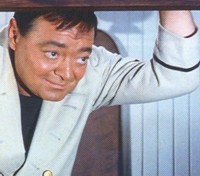
Peter Lorre as the steward. One of many cameos |
Liner notes
The liner notes mix-up some Widescreen movie history placing the introduction of Cinerama after that of CinemaScope. In reality, it was the overwhelming success of the giant three-screen Cinerama process, which Mike Todd helped bring to the screen, that, along with the 3-D process, sent Hollywood looking for other new screen processes like CinemaScope. When Todd's connection with the Cinerama organization was severed, he looked around for another huge screen process, "Cinerama through one eye," as he would say, which became Todd A-O, named for himself and his partners, the American Optical company. Otherwise, the liner notes are well written with a number of attractive color stills from the movie.
Hit Parade Records (www.ericrecords.com) specializes in easy listening and rock 'n roll from the 1950s and 1960s. This is such a pleasing package that one hopes they will release other movie soundtracks in the future.
|



